Arizona Wildlife Parenting 101
by Nathan Thrash
Liberty Wildlife Staff
There are a lot of different parenting techniques out there. Luckily for us humans, we can peruse the internet, get a book at Barnes and Noble, or rely on the wisdom of our own parents for tips on how to raise our kids. Unfortunately, if you’re not a human (how are you reading this?), you must rely on your instincts to raise your young. Let’s take a look at some of the techniques our feathered and furred friends have to raise their young.
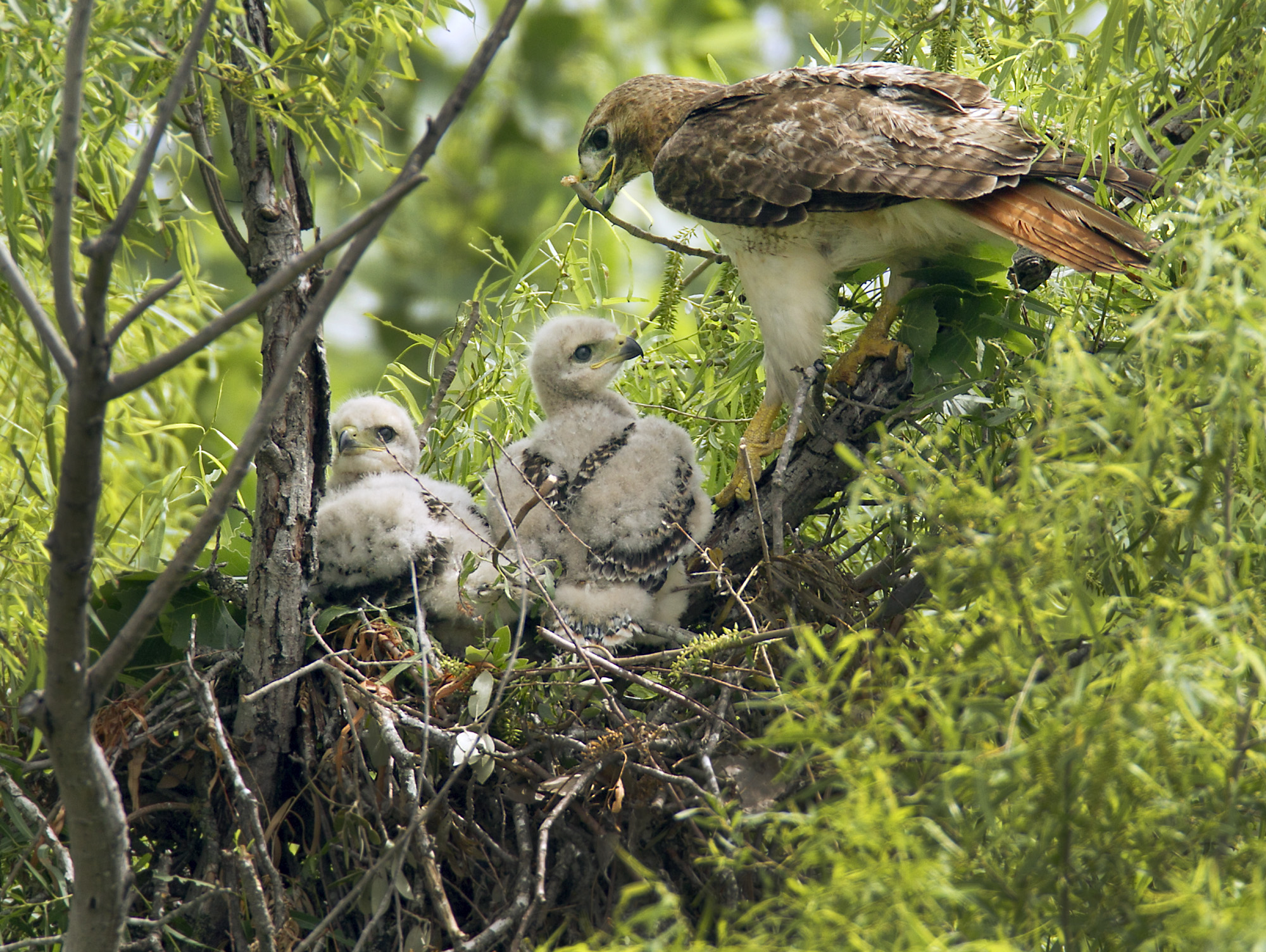
Red-tailed hawks are the most common hawks seen in Arizona, and they are some of the most common hawks across the United States. So how do they raise their young? A typical Red-tailed hawk nest has two eggs that the female sits on (incubates) for around a month. Once the eggs hatch, both parents share hunting duties to feed their babies. After about 42-48 days, the hatchlings become fledglings and leave the nest for the first time. After about 4 months of learning how to hunt from their parents, the juveniles leave the nest, never to return.
The story of how Red-tailed hawks raise their young is fairly standard among hawks. Once they’ve been raised and leave the nest to find their own territory, and they never see their parents again. Harris’s hawks, however, are a different story.

Sometimes referred to as ‘the wolves of the sky’, Harris’s hawks are extremely social cooperative hunters. Their family groups typically include between 2-7 birds, led by an alpha female. The alpha female usually lays 2-3 eggs, and she does most of the incubation. The alpha male and the rest of the family group do the hunting and feed the female, with members of the family group
occasionally relieving her of her incubation duties. Once the eggs hatch, the young birds typically spend 45-47 days in the nest before leaving for the first time. After that, some of the young leave after 2-4 months, and some stay to be a part of the family group. The young who stay will remain with their parents for up to 3 years to help raise subsequent broods.
Speaking of animals that travel in family groups, lets explore how Coatimundis raise their young. Coatimundi (Coati) are racoon-sized crepuscular mammals that live in the American Southwest, including Arizona. Male Coati are usually solitary, but females and their young travel in family bands of between 4-40 members. During mating season, a male will temporarily join a family band to mate. Once he’s mated with a female, all the rest of the females in the band will force him to leave (those males can be pretty obnoxious). When the female is ready to give birth, she leaves the band and gives birth to her litter in a nest made in the crevice of a tree. The young leave the tree when they’re about 4 weeks old. After 1 -2 weeks of leaving the tree for the first time, the group rejoins the family band. The young stay with the band until the mother leaves again to give birth to her next litter.
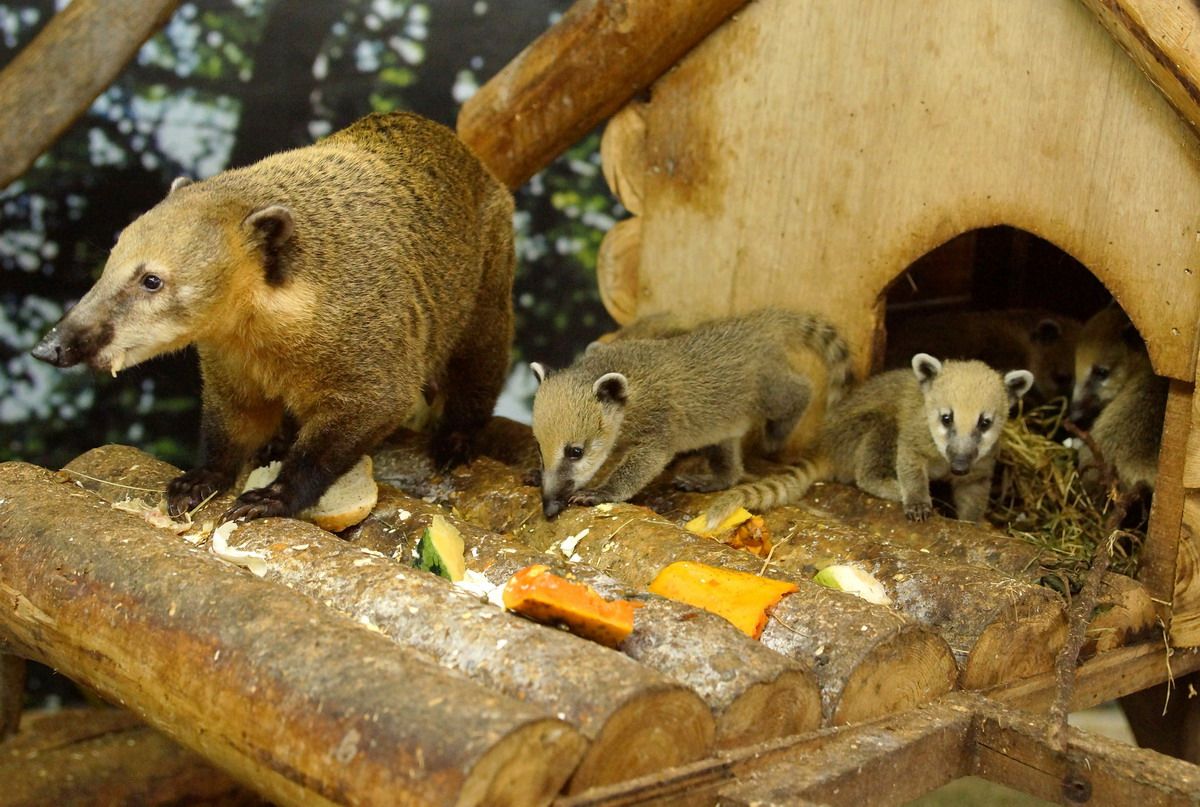
Finally, let’s take a look at a charismatic bird typically associated with the Southwest – the Greater Roadrunner. Both of the roadrunner parents incubate the egg, with the male taking the night shift and the female taking the day shift. Once the eggs hatch, the male will continue to brood them over night. Once the nestlings are about 4 days old, they will often be left alone while the parents hunt. Since they are often left alone, clutch replacement due to nest predation is fairly common. Roadrunners also sometimes practice nest parasitism, where they will leave their eggs in a Raven or Mockingbird nest, and let another bird raise their young. Hatchlings leave the nest at around 14-25 days old, and will hunt with their parents for another month or two. Once the young have outstayed their welcome, the parents will attack and chase those no-good kids out of their territory. If you think that’s bad parenting, consider this: during severe food shortages, Greater Roadrunners have been known to eat their own young. Glad I wasn’t raised by a Greater Roadrunner!
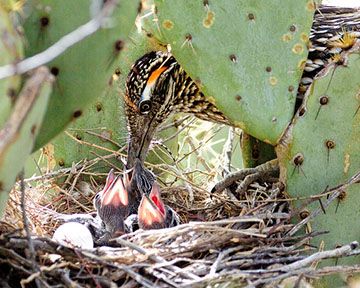
Earth Day Legacies
by Gail Cochrane
Liberty Wildlife volunteer
This year is the 50th anniversary of Earth Day. The first Earth Day was largely inspired by Rachel Carson’s best-selling book Silent Spring, a clarion call that raised public awareness and concern for living organisms and the environment, and highlighting the links between pollution and public health.

U.S. Senator Gaylord Nelson was instrumental in getting the first Earth Day off the ground. In 1969 he witnessed the ravages of a massive oil spill off the coast of Santa Barbara and was motivated to create a plan to pull the energy of the anti-war movement towards the emerging awareness of air and water pollution.
Senator Nelson first announced the idea for a national teach-in on the environment to the national media. He recruited Pete McCloskey, a Republican congressman to be co-chair, and 25-year-old Harvard student Denis Hayes to be the coordinator. Ultimately 20 million people came to the streets on April 22, 1970, in a mass protest that spurred the development of the Clean Air Act, the Clean Water and Endangered Species Acts and the creation of the Environmental Protection Agency.
As 1990 approached, a group of environmental leaders asked Denis Hayes to organize another major campaign for the planet. This time, Earth Day went global, mobilizing 200 million people in 141 countries and lifting environmental issues onto the world stage. Earth Day 1990 gave a huge boost to recycling efforts worldwide and helped pave the way for the 1992 United Nations Earth Summit in Rio de Janeiro.
As the millennium approached, Hayes agreed to spearhead another campaign, this time focused on global warming and a push for clean energy. With 5,000 environmental groups in a record 184 countries reaching out to hundreds of millions of people, Earth Day 2000 built both global and local conversations, leveraging the power of the Internet to organize activists around the world.
The non-profit Earth Day Network is coordinating Earth Day 2020 initiatives. The theme for Earth Day 2020 is Climate Action, a call for greater global ambition to tackle the climate crisis. Innovation, ambition, and bravery will be needed to meet the growing crisis and to seize the opportunities of a zero-carbon future.
A number of campaigns are underway. Please see the Earth Day Network website to read more about these initiatives and to learn how you can help.
EARTHRISE is a global movement for climate action that will mobilize millions on April 22.
The Great Global Clean Up is a world-wide trash pick up to reduce waste and plastic pollution – improving habitats and preventing further harm to wildlife and humans.
Earth Challenge 2020 is the largest ever global citizen science initiative allowing everyday individuals tools to report on water quality, air quality and health of species around them.
Foodprints for the Future addresses one of the largest contributors to climate change – our food systems.
Artists for the World is a global campaign bringing artists to the forefront to express our common humanity.
There will be many more local efforts to engage people in Earth Day this year, I hope you will find some way to help. And remember, Earth Hour coming up soon, on March 28. This is a time to turn off electric lights and technology and spend time with family and friends, perhaps making resolutions of ways to help the Earth. Now is the time to mobilize to save the planet!
The Not-So-Ordinary Red-tailed Hawk
by Claudia Kershcer
Liberty Wildlife volunteer

Rufous Morph Red-tailed Hawk
One of the most familiar and widespread large hawks in North America, the Red-tailed Hawk, can sometimes be difficult to identify. There are 14-16 subspecies (recognized by various authorities) which vary in appearance and range. Most can be recognized by their reddish-brown tail, BUT the rest of their plumage can be quite variable, ranging from blackish to rufous-brown to nearly white. Each subspecies can also have 3 color morphs: light, dark, and intermediate.
United States and Canada:
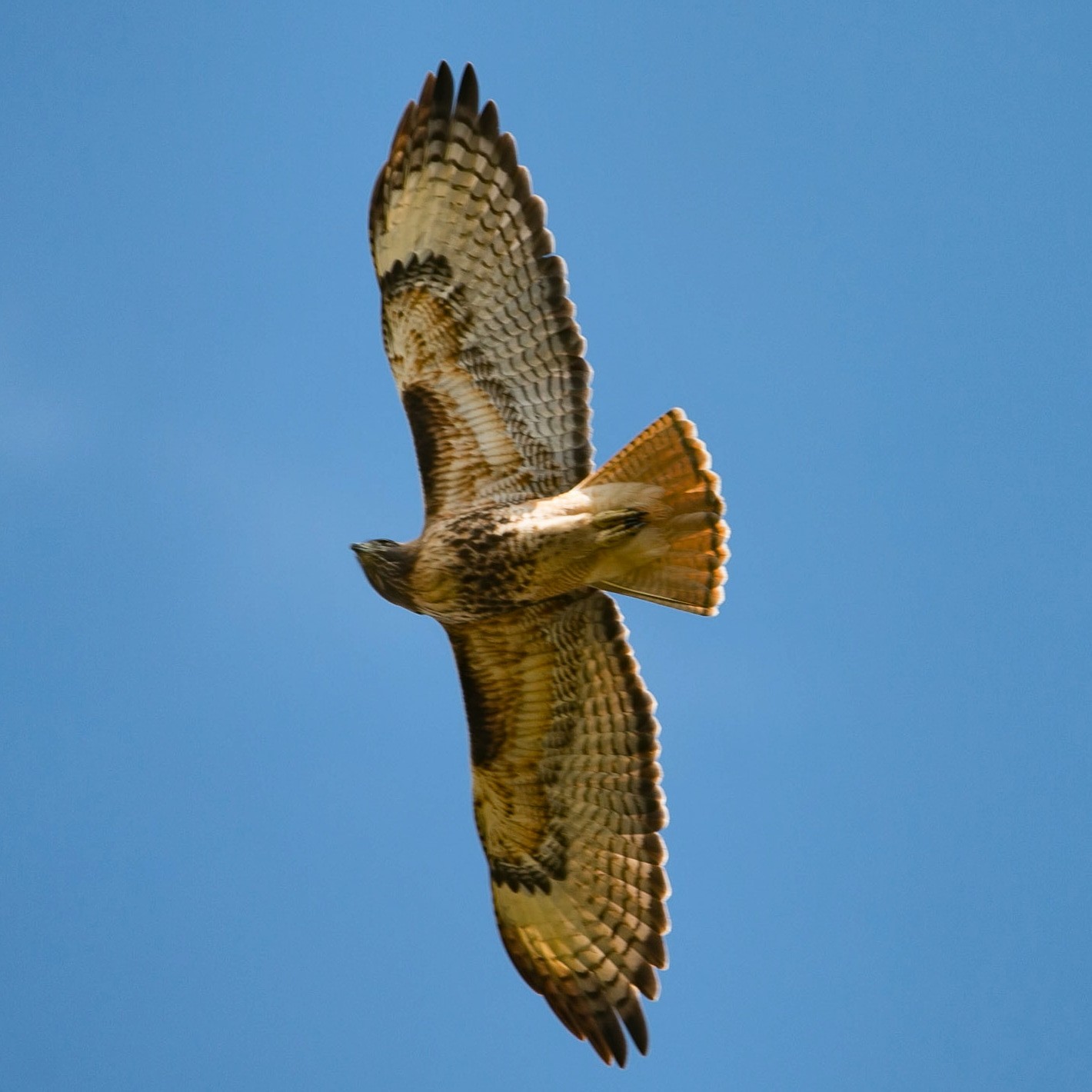
Alaskan Red-tailed Hawk (Buteo jamaicensis alascensis) – Range: SE coastal Alaska to Vancouver BC.

Eastern Red-tailed Hawk (Buteo jamaicensis borealis) – Range: Migratory. From SE Canada to Maine to Texas and Florida.

Krider’s Red-tailed Hawk (Buteo jamaicensis kriderii) – considered by some to be a pale morph of Eastern RTH. Range: Canada to midwest states to winter in Arizona, New Mexico, and Texas.
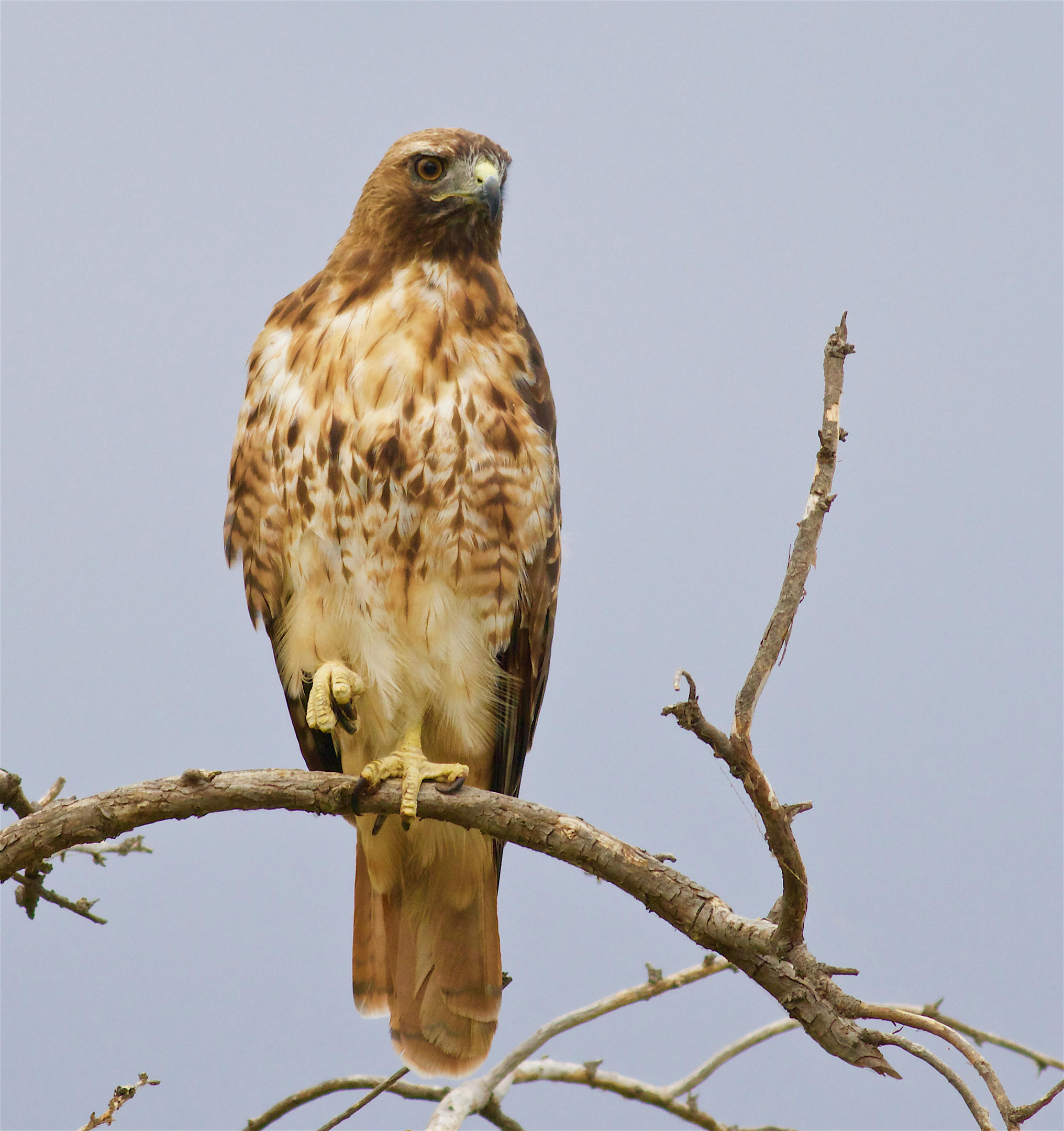
Western Red-tailed Hawk (Buteo jamaicensis calurus) – Range: Migratory western North American population. Winters as far south as Nicaragua.
Canadian Red-tailed Hawk (Buteo jamaicensis abieticolus) – Range: Western Canada
Florida Red-tailed Hawk Buteo jamaicensis umbrinus) – Range: Resident in peninsular Florida north to Tampa Bay and the Kissimmee Prairie.
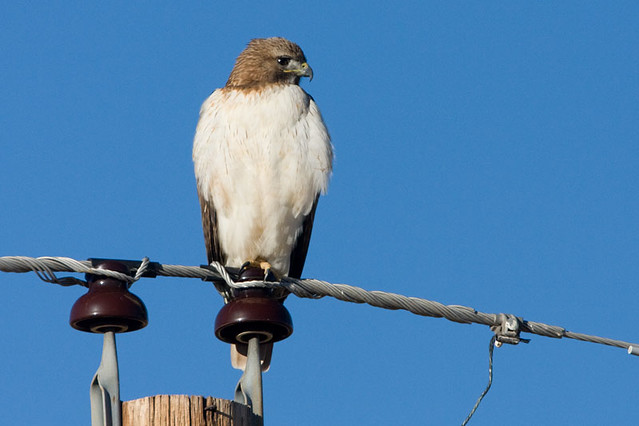
Fuertes’s Red-tailed Hawk (Buteo jamaicensis fuertesi) – Range: Migratory. Breeds from northern Chihuahua to southern Texas. Winters in Arizona, New Mexico, and southern Louisiana.
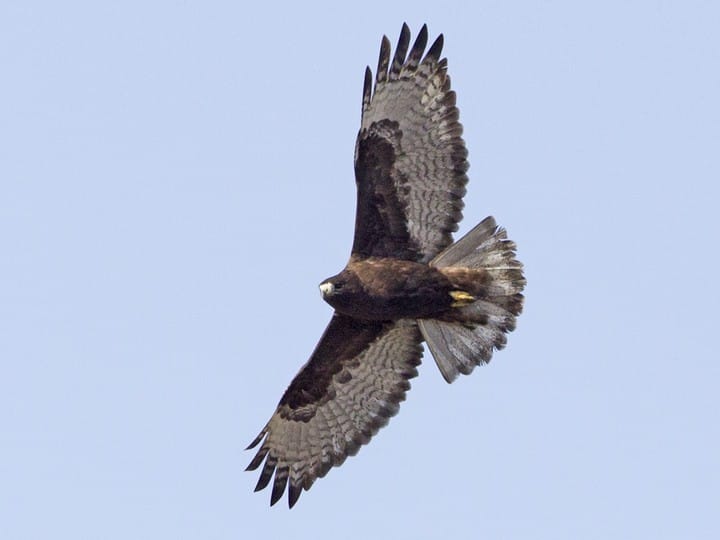
Harlan’s Hawk (Buteo jamaicensis harlani) – previously considered a full species (Buteo harlani) or a color morph of ssp. calurus. Debate about its status is still ongoing. Range – Range: Migratory – breeds in Alaska and northwestern Canada and winters from Nebraska and Kansas to Texas, Arizona and northern Louisiana
Other regions:
Saint Lucas Red-tail ( Buteo jamaicensis lucasanus) – Range: Baja California.
Caribbean Red-tailed Hawk, Jamaican Red-tailed Hawk (Buteo jamaicensis jamaicensis), Range: Jamaica, Hispaniola, Puerto Rico and the Lesser Antilles. Not found on the Bahamas or Cuba.
Central American Red-tailed Hawk, Costa Rican Red-tailed Hawk (Buteo jamaicensis costaricensis) Range: Resident from Nicaragua to Panama.
Tres Marias Red-tailed Hawk (Buteo jamaicensis fumosus) Range: Islas Marías, Mexico
Buteo jamaicensis hadropus – Range: Mexican Highlands
Socorro Red-tailed Hawk (Buteo jamaicensis socorroensis) Range: Socorro Island, Mexico
Cuban Red-tailed Hawk (Buteo jamaicensis solitudinus) – Range: Bahamas and Cuba
Buteo jamaicensis kemsiesi – Range: Resident in Chiapas(southeastern Mexico) to Nicaragua.

Calurus Dark Morph Red-tailed Hawk
References: Allaboutbirds.org, beautyofbirds.com, birdsna.org
Kid Stuff
By Carol Suits

Happy 50th Anniversary!
Earth Day is April 22nd. How do you plan to celebrate this important day?
Create a silly Earth Day story by filling in the blanks.
https://kids.nationalgeographic.com/games/funny-fill-in/dreaming-green/
Here’s an Earth Day challenge! How GREEN are you? Try this quiz.
https://kids.nationalgeographic.com/games/quizzes/earth-day-quiz-whiz/
Find a good book to read!
By Don Madden
The town is being buried in trash. Careless citizens are throwing gum and soda bottles on the ground! One tidy man realizes he has the power to get rid of the trash and teaches the town a lesson. This is a fun and silly book with a wonderful message.
10 Things I Can Do to Help Save My World
By Melanie Walsh
Kids are encouraged to do 10 simple things that can have a big impact on the world from turning off the water when you brush your teeth to picking up trash.
By DyAnne DiSalvo-Ryan
A vacant lot sits in the middle of a city block. A young girl has an idea to turn the run-down lot into a green space. How does she get her neighbors to help her? At the end of this book are tips for starting your own community garden.
Puzzle fun!
https://www.jigsawplanet.com/?rc=play&pid=06ff8211dfa5


